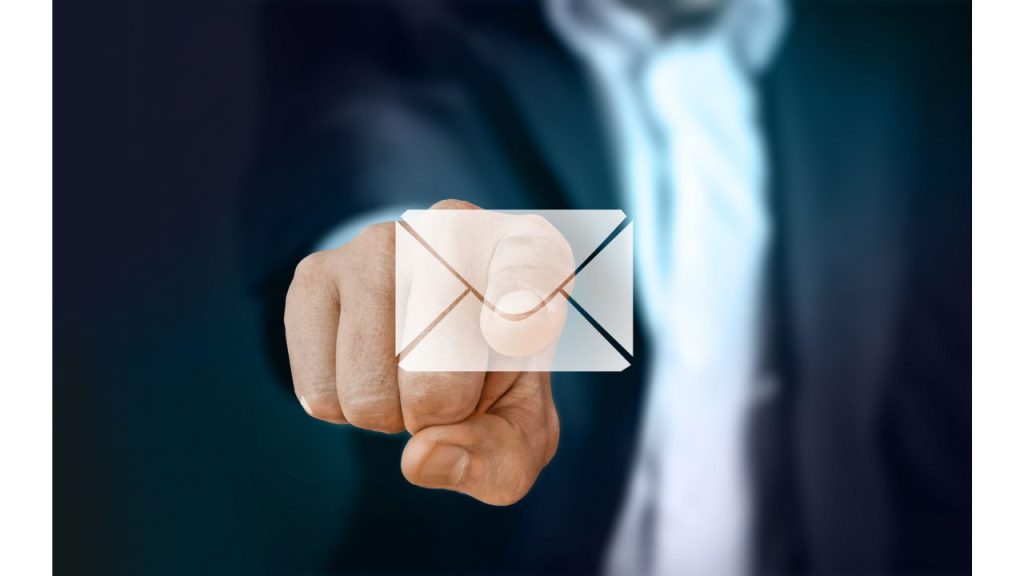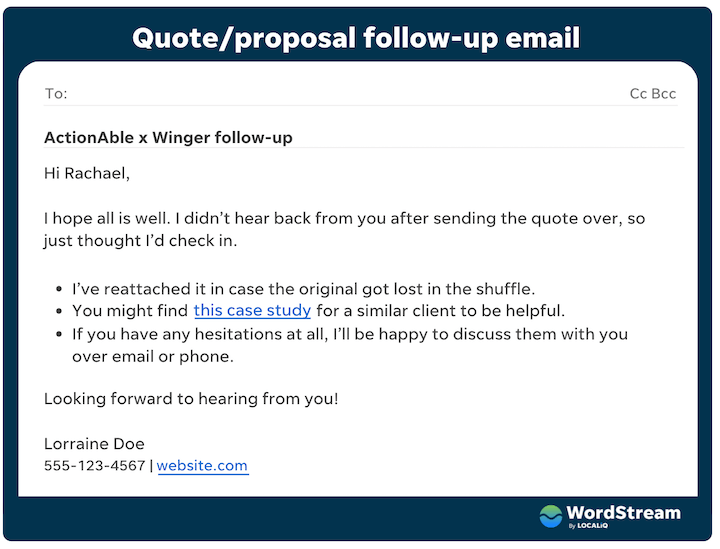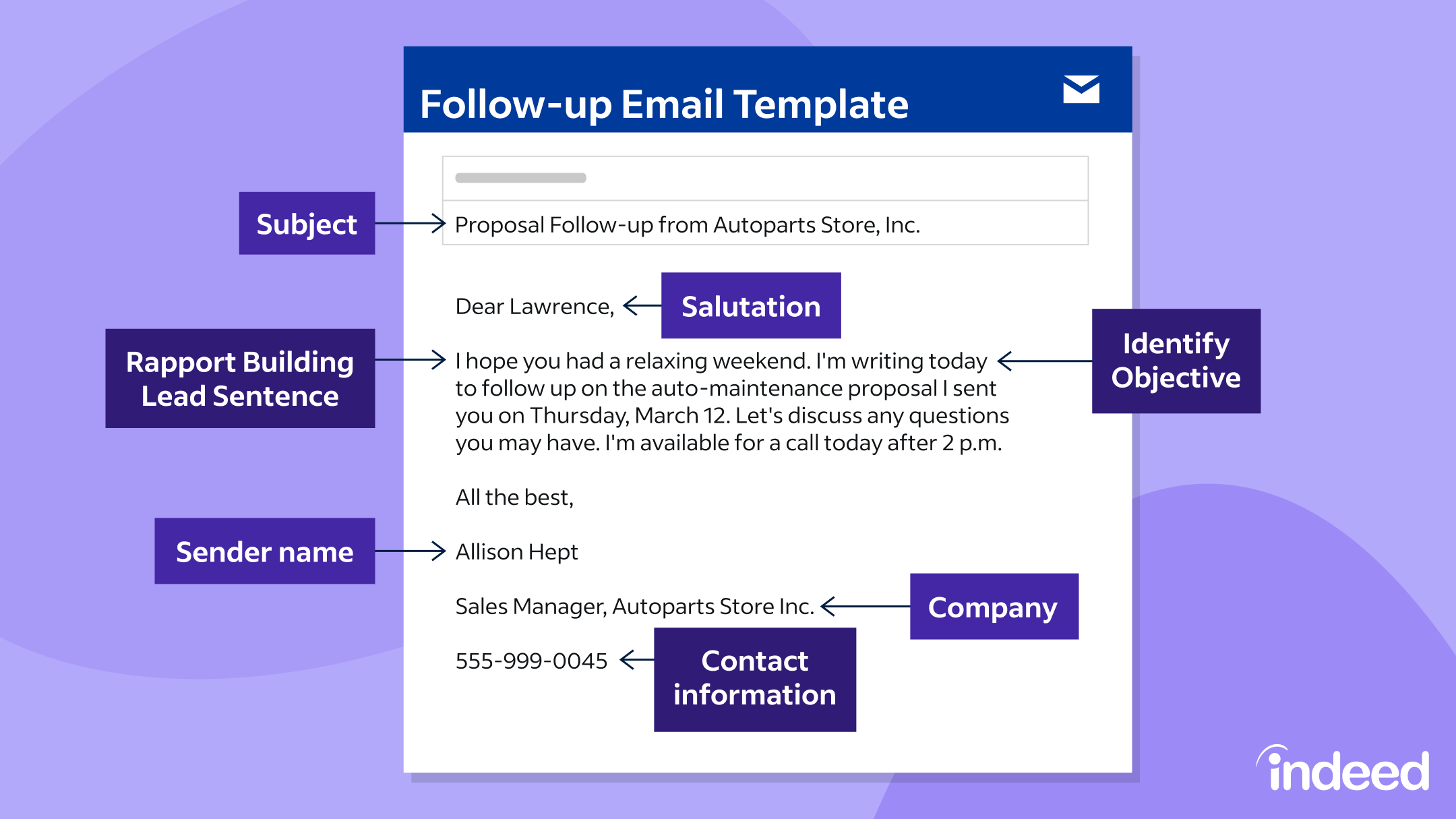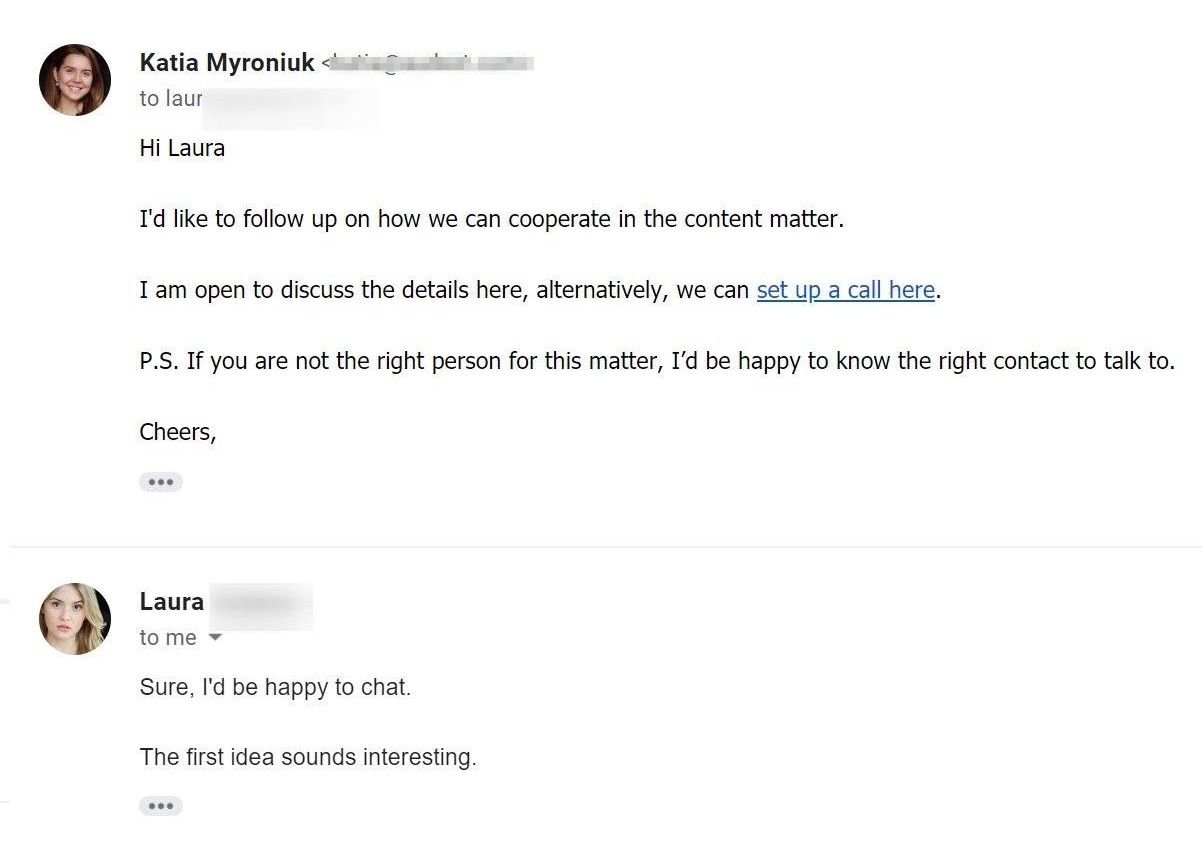
A follow-up email is a communication sent to remind or request further action. It ensures ongoing engagement and can clarify previous interactions.
Follow-up emails play a crucial role in maintaining professional relationships and ensuring tasks are completed. They serve as reminders and help in tracking progress. Crafting an effective follow-up email requires clarity, politeness, and a concise message. Address the recipient directly and reference any previous communication.
Highlight the purpose of your follow-up. A well-written follow-up email demonstrates your commitment and professionalism. It can also expedite responses and improve collaboration. Remember to keep your message short and to the point. This makes it easier for the recipient to read and respond promptly.

Credit: www.wordstream.com
The Art Of Crafting Effective Follow-up Emails
Writing follow-up emails can be tricky. It would help if you reminded me, not annoyed. This art requires skill, timing, and a polite tone. Mastering it can boost your success.
Balancing Persistence With Politeness
Your follow-up email should show persistence. But, it must also be polite. Here are some tips to achieve this:
- Use a friendly tone.
- Avoid sounding pushy.
- Please show respect for their time.
- Express gratitude.
For example:
Dear [Name],
I hope this email finds you well. I wanted to follow up on my previous email.
Thank you for your time and attention.
Best regards,
[Your Name]
Timing Your Outreach
The timing of your follow-up email is crucial. Too soon, and it feels pushy. Too late, and they forget you. Consider these timelines:
| First Follow-Up | 3-5 days after the initial email |
|---|---|
| Second Follow-Up | 7-10 days after the first follow-up |
| Third Follow-Up | 2 weeks after the second follow-up |
Stick to this schedule for the best results. Be patient, yet consistent.
Subject Line Strategies That Open Doors
Writing a follow-up email is crucial in many professional settings. The subject line plays a vital role in whether your email gets opened. A compelling subject line can make all the difference. Let’s explore strategies to craft subject lines that grab attention and encourage recipients to open your email.
Creating Curiosity
Curiosity drives people to open emails. A subject line that teases information can be very effective. For example:
- “You Won’t Believe What Happened Next…”
- “An Idea That Can Change Everything”
- “Guess What We Discovered?”
These examples make the reader curious. They want to know more. Keep the mystery without being too vague. Make sure the email content delivers on the promise of the subject line.
Personalization Tactics
Personalization can significantly increase open rates. Using the recipient’s name in the subject line makes it feel more tailored. Examples include:
- “John, Are You Free for a Quick Call?”
- “Sarah, We Have an Update for You”
- “Mark Here’s Something You’ll Love”
Besides names, you can also use specific details. For instance:
- “Your Project Progress Report Inside”
- “A Special Offer Just for Your Needs”
- “Updates About Your Recent Inquiry”
Personalized subject lines show effort and attention to detail. They make the recipient feel valued. This increases the chances of your email being opened.
Opening Lines That Hook The Reader
Writing follow-up emails can be tricky. The first line must grab attention. You need to engage the reader right away. Strong opening lines can set the tone. They can make your email memorable. Let’s explore some effective techniques.
Referencing Previous Interactions
Start by mentioning past conversations. This shows you remember. It makes the email feel personal. Use specific details to jog their memory.
- “It was great meeting you at the conference last week.”
- “I enjoyed our chat about the new project on Tuesday.”
- “Thank you for your time during our call yesterday.”
These lines remind the reader of your last meeting. They create a connection. It shows you value the interaction.
Expressing Genuine Interest
Show you care about their needs. This makes the reader feel valued. Use questions or statements that show interest.
- “I was thinking about your challenge with X.”
- “I found some solutions that might help your project.”
- “I am eager to hear your thoughts on our proposal.”
These lines show you are invested. They make the reader more likely to respond. Genuine interest builds trust and rapport.

Credit: www.indeed.com
The Core Message: Making Your Point Clearly
Writing a follow-up email can be tricky. You want to be clear and direct. Your core message must stand out. Here, we explore key elements to achieve this.
Providing Context
Always start by providing context. Explain why you are writing. Mention any previous interactions. This helps the reader understand your email.
For example:
| Good Example | Bad Example |
|---|---|
| Good: “I am writing to follow up on last week’s meeting.” | Bad: “I want to discuss something.” |
Being Concise And Direct
Get to the point quickly. Use short sentences. Avoid unnecessary words. The reader should understand your message easily.
Here are some tips:
- Use bullet points for clarity.
- Limit each paragraph to one main idea.
- Use simple words and phrases.
For example:
| Good Example | Bad Example |
|---|---|
| Good: “Please send the report by Friday.” | Bad: “I was wondering if you might be able to send the report by the end of the week, if possible.” |
Call To Action: What Do You Want Them To Do?
A follow-up email should always have a clear call to action (CTA). A CTA guides the reader on what to do next. Without a CTA, your email may not achieve its goal. The CTA can be an invitation to a meeting, a request for feedback, or a download link. It depends on the email’s purpose. Let’s dive into how to craft the perfect CTA.
Choosing The Right Cta
Selecting the right CTA is crucial. It should be clear and direct. The reader should know exactly what you want them to do. Here are some tips for choosing the right CTA:
- Keep it Simple: Use clear and simple language. Avoid jargon.
- Be Specific: Tell them exactly what action to take. For example, “Click here to download the report.”
- Align with Goals: The CTA should align with your email’s goal. If you want feedback, say, “Please reply with your thoughts.”
Urgency Without Pressure
Creating urgency can increase response rates. But, it should not feel like pressure. Here are some ways to create urgency without pressure:
- Use Time-Limited Offers: Mention limited-time offers. For example, “Offer ends in 3 days.”
- Highlight Benefits: Show how taking action now benefits them. For example, “Get early access to our new feature.”
- Friendly Reminder: A gentle reminder can create urgency. For example, “Don’t miss out on our webinar tomorrow.”
A well-crafted CTA can make your follow-up emails more effective. Choose the right words and create urgency carefully.
Tone And Professionalism: Striking The Right Balance
Crafting the right follow-up email is an art. It’s crucial to strike a balance between tone and professionalism. The email should be polite, yet firm. It must reflect your personality but also maintain a professional demeanor. This balance is key to effective communication and can enhance your business relationships.
Maintaining A Professional Tone
A professional tone shows respect. It signals that you value the recipient’s time and effort. To achieve this, use formal language. Avoid slang or overly casual phrases.
- Start with a polite greeting.
- Use complete sentences.
- Be clear and concise.
Here’s an example:
I hope this message finds you well. I am writing to follow up on our previous conversation regarding [subject].
Injecting Personality
While professionalism is important, adding a bit of personality can make your emails more engaging. This helps build rapport and makes your emails more memorable.
- Use a friendly tone.
- Share a personal anecdote.
- Express genuine interest.
Here’s an example:
I hope you’re having a great day! It was a pleasure chatting with you about [subject].
Striking the right balance between tone and professionalism in follow-up emails is crucial. It ensures your message is well-received and effective.
Follow-up Frequency: How Much Is Too Much?
Follow-up emails are essential for business. They can keep you on a prospect’s mind. But sending too many can annoy them. So, how often should you send follow-ups? This guide will help you find the right balance.
Determining Optimal Follow-up Times
The key is to find a sweet spot. You want to remind, not annoy. Here are some tips:
- First follow-up: Send 2-3 days after the initial email.
- Second follow-up: Wait 4-5 days before sending.
- Third follow-up: Allow 7-10 days after the second email.
This schedule balances persistence and patience. It gives prospects enough time to respond.
Recognizing When To Stop
Knowing when to stop is vital. Too many emails can harm your reputation. Here’s how to recognize the stopping point:
| Sign | Action |
|---|---|
| No response after 3-4 emails | Consider stopping |
| Negative replies | Stop immediately |
| Open rates drop | Re-evaluate your strategy |
Always be respectful. If someone asks you to stop, do so. Respect their wishes.
Leveraging Technology For Follow-up Success
In today’s fast-paced world, timely follow-up emails are crucial. Technology can help streamline this process. Using the right tools can make follow-ups more efficient and effective. Here’s how you can leverage technology for follow-up success.
Email Tracking Tools
Email tracking tools are essential for follow-up success. They help you know if someone has opened your email. You can also see if they clicked any links. This information is valuable. It tells you who is interested in your message.
- Open Tracking: Know when your email is read.
- Link Tracking: See if links are clicked.
- Reply Tracking: Get notifications on replies.
Popular email tracking tools include:
| Tool | Features |
|---|---|
| Mailtrack | Real-time notifications, link tracking |
| Yesware | Email analytics, CRM integration |
| Mixmax | Send later, templates, reminders |
Automated Reminder Systems
Automated reminder systems ensure no follow-up email is missed. They automate the process of sending reminders. This saves time and effort.
- Set Reminders: Schedule follow-up emails.
- Custom Templates: Use pre-written messages.
- Automatic Sending: Emails go out at the right time.
Some effective reminder systems are:
| Tool | Features |
|---|---|
| FollowUp.cc | Email scheduling, reminders |
| Boomerang | Send later, follow-up reminders |
| Gmelius | Shared inboxes, email sequences |
These tools make follow-up emails easy. They ensure you stay on top of your communication game.
Analyzing Responses: What They Mean
Understanding the responses to your follow-up emails can be tricky. Not all replies are straightforward. Sometimes, you need to read between the lines. By analyzing responses, you can improve your email strategy. This section will guide you in interpreting those responses effectively.
Reading Between The Lines
Responses often have hidden meanings. A reply might seem positive but mean something different. Look for keywords and phrases that indicate the true intent. For example:
- “Let me get back to you” might mean the person is not interested.
- “I am busy right now” could be a polite way to decline.
- “Sounds good” might indicate genuine interest but needs a follow-up.
Pay attention to the tone of the email. A brief response may suggest disinterest. A detailed reply often shows engagement. Use these cues to gauge the actual message.
Adjusting Your Approach
Once you understand the response, adjust your approach. If the reply seems hesitant, offer more information or reassurances. If the response is positive, act quickly to move things forward. Here are some tips:
- For a neutral response, ask open-ended questions to keep the conversation going.
- If the reply is negative, thank them for their time and ask for feedback.
- For positive responses, provide clear next steps and express enthusiasm.
Always be polite and professional. Tailor your next email to match the tone and content of the response. This shows you are attentive and responsive.
| Response Type | Recommended Action |
|---|---|
| Neutral | Ask open-ended questions |
| Negative | Thank them and ask for feedback |
| Positive | Provide clear next steps |
By analyzing and adjusting, you can improve your follow-up email success.

Credit: hunter.io
Common Mistakes To Avoid In Follow-up Emails
Writing follow-up emails can be tricky. Mistakes can make you seem unprofessional. Here are common mistakes to avoid in follow-up emails.
Overlooking The Follow-up Email Etiquette
Respecting email etiquette is crucial. Make sure your email is polite. Avoid being too pushy. Here are some etiquette tips:
- Avoid sending follow-up emails too soon.
- Always include a greeting and a closing.
- Check your spelling and grammar.
Follow these rules to make a good impression. Always be polite and respectful.
Neglecting Personalization
Personalization is key in follow-up emails. Generic emails often get ignored. Make your email stand out with these tips:
- Use the recipient’s name.
- Refer to previous interactions.
- Mention specific details about your last conversation.
Personalized emails show you care. They are more likely to get a response. Spend time to make each email unique.
Frequently Asked Questions
How Do You Write A Follow-up Email?
Start with a polite greeting. Mention the previous interaction. State the purpose clearly. Include a call to action. Sign off courteously.
How Do You Politely Start A Follow-Up Email?
Start with a friendly greeting and mention the previous interaction. For example, “Hi [Name], I hope you’re well. I wanted to follow up on our last conversation regarding [topic]. “
How Do I Professionally Say I’m Following Up?
I’m following up on my previous email. Could you provide an update on the status? Thank you.
How Do You Politely Follow Up On An Email After No Response?
Send a polite follow-up email. Express understanding, restate your request and ask if they need more information. Keep it concise and courteous.
Conclusion
Crafting an effective follow-up email is essential for maintaining professional relationships. Keep your messages concise, clear, and personalized. Use these tips to improve your communication and increase response rates. Remember, a well-written follow-up can make a significant difference. Start implementing these strategies today for better results.
